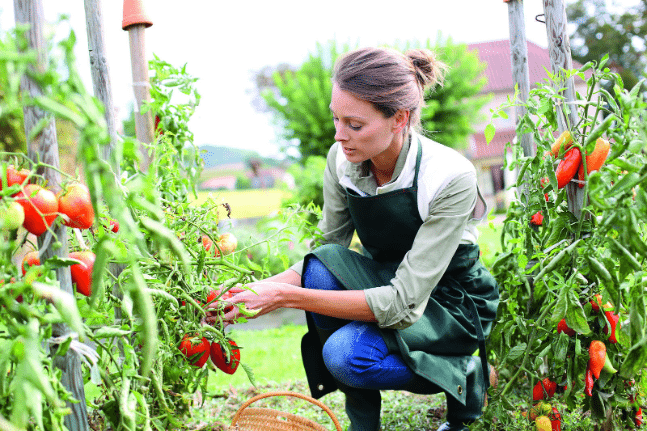How to create the perfect no-dig garden
I have five rules of vegie gardening:
1. Plant something every week
2. Plant whenever you take something out
3. Plant as many perennial veg as you can
4. Never, ever dig
5. Mulch, mulch and mulch some more
The backbone of our vegetable garden is the perennials: garlic chives, chives, Italian chicory, yacon, Jerusalem artichokes, artichokes, chilli, cassava, Warrigal spinach, Malabar spinach, garlic, chilacayote melons, Russian garlic, shallots, spring onions and, in spring, asparagus, asparagus, asparagus. No matter how much asparagus we grow, it is never enough.
If we were in a slightly warmer climate, I’d add sweet potatoes to the list.
Every spring and summer I add parsley, silver beet, carrots, tomatoes, potatoes, corn, beans, beetroot, lettuce, coriander, pumpkins, zucchini, melons, cucumber and rocket … and whatever other odd veg I have a fancy to try. Every time I remove a spent crop, throwing them down for mulch, I plant in their place: more beans, lettuce etc over summer and then, as autumn approaches, bok choy and broccoli and cabbages and Brussels sprouts, as well as English spinach.
Every spring I mulch the perennial veg well, and mulch around all the new veg once they are about finger high. The mulch both keeps down weeds and keeps in moisture. If it’s good mulch, like compost, I don’t add any feeding. If it’s good but doesn’t contain quite enough nutrients (mulch like pea straw or lucerne), I add a little hen manure a few times a year. And if it has hardly any nutrients but is great for soil conditioning, like woodchips from trees or prunings added in winter, then I feed the mulch to help it break down into good soil at least once a fortnight. But I am feeding the soil, not the plants, so that we never get a burst of sappy, nitrogen-fuelled growth.
Vegetable gardens — the kind to feed you and delight you — should not be hard work.
It works. Though one of my dreams is to spend every day tending vegetables and flowers — it is my idea of paradise — in reality I either have little time or it’s hot enough to fry an egg on the shed roof and far too hot to garden, or so cold the wombat droppings have white whiskers from frost. I am not a masochist. While I love to walk in frosty weather, wearing gloves, hat, coat and long johns, I don’t long to have my hands in cold soil.
Which leaves autumn and spring, plus picking either in the warmth of midday in winter or the cool of early morning or dusk in summer. And I have to ration myself to an hour in the garden in spring and autumn or I’d never get other work done.
Early this spring, I transplanted new asparagus seedlings from last year into their new home — lovely purple sprouting asparagus — and I can’t wait till we taste it next year or the one after. I also planted bean seeds, checked the artichokes for buds, picked carrots, parsnips, shallot tops, silver beet, bok choy, garlic tops for a stirfry and checked to see if there were any broad beans yet. (There weren’t.)
Spring is also the time to pay attention to the giant pile of autumn leaves I’ve deposited in a sunny spot months earlier. They decay nicely over winter and the grass and weeds under them die. In early spring, I part them to make a clear space about 20cm square and plant melons and pumpkins in the damp soil below. Then I place chicken wire on top, so the lyrebirds don’t scratch away leaves and seedlings (if you don’t have lyrebirds or bush turkeys or backyard free-range chooks you can omit this step). I scatter on some elderly chook manure (thank you, chooks) to help the leaves break down faster, then I water the lot. After a fortnight, I feed them again and keep doing that till the leaves are almost soil and the melons and pumpkins swell nicely.
Last year my “pile of autumn leaves garden” became a tomato and cucumber garden. This year, because that soil was so very, very tempting, it was planted with melons, small sweet watermelons and rockmelons. If you have ever tasted a homegrown tomato and realised how fragrantly delicious it is compared to a supermarket one, wait till you have tasted sun-ripened melons, straight from garden to your mouth, or possibly with a very, very brief chill in the fridge — though not too much, as cold destroys so much of the melon’s flavour, which is why the ones you buy have more texture and colour than taste.
Vegetable gardens — the kind to feed you and delight you — should not be hard work. If you don’t have autumn leaves handy, use compost or lucerne hay or pea straw. If you don’t want to leave them long enough for the grass to die below, just pile it higher — at least half a metre — then put a 30cm layer of compost or potting mix on top, and plant on that … and feed and water as above.
Not hard. Then watch and smell and pick and plant … and just keep doing it, every week you can, for years or decades, and hope that at the end of it paradise will be a garden.








